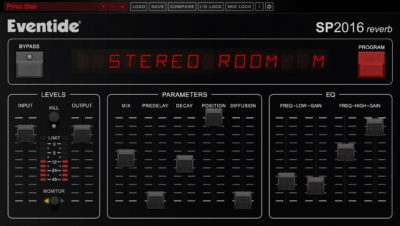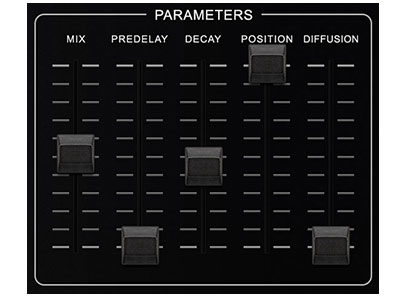New Software Review: SP2016 Reverb by Eventide

Although the algorithms of the original SP2016 have been modeled before, Eventide’s new SP2016 Reverb plugin is the first direct, top-to-bottom emulation of this classic piece of hardware.
In 1981, Eventide released the SP2016 multi-effects rack processor, a unit that arguably helped coin the term plugin as we know it today.
The original SP2016 came with various algorithms, including both a Room and Plate reverb, and a little later, the Stereo Room algorithm was released as a “plug-in” ROM chip that you inserted into the SP2016.
Eventide had released a plugin based off the original SP2016 ROM algorithm before, called 2016 Stereo Room, but their brand new SP2016 Reverb plugin is a direct emulation of this classic unit, and includes all three of the above mentioned algorithms. Today we’ll take a look the new plugin version and see if it as well can stand the test of time.
Features and Use
Upon opening an instance of SP2016, you’ll be greeted by faders on the left-hand side for input and output level, a “Kill” button that cuts the input signal, and a Bypass switch. On the right-hand side, a Program button provides the option of Vintage or Modern interpretations of Stereo Room, Room, and Plate reverb. Vintage Plate only offers controls for Mix, Pre-Delay, and Decay, while all of the other Vintage and Modern programs (including Modern Plate) also include Position, Diffusion, and basic low and high EQ control.
The SP2016 reverbs have a lot of character thanks to the Position control which, put simply, alters the perceived origin of the sound within the room. When set to high values, it gives the impression that sound is coming from the back of a room, and when set low, gives the impression that the sound is being generated closer to you.
One of my favorite mixers, Alan Meyerson, turned me on to a trick with the older 2016 Stereo Room: start with the default preset, set the mix to 100% wet, and the Position between 1-10%; this keeps solo instruments centered and present but places them slightly further away, leaving more space for other sonic elements to come into focus.
I’ve had great success with this method, especially with instruments like guitars and pianos/synths which tend to compete for space with lead vocals. I find I have to do less work with EQ when I also factor in the perceived location and space of my sounds.
Vintage Stereo Room is great for creating a slapback echo sound if you put the pre-delay time above 100ms; it’s a cool way to add a throwback vibe to guitars and vocals. The Vintage setting has a little less shine in the high end than Modern, but that’s not necessarily a bad thing. On high brass and strings, the Vintage version seems to nicely tame the shrillness of the source material, and when used on close mics, it actually sounds like the brass and winds were recorded with tree mics (placed above the conductor’s head in an orchestral setting) or ambient mics!
The Modern Room setting can produce some very cool and massive sounds when the decay is set between 8-100 seconds. It reminds me of Eventide’s Blackhole reverb, and is a great tool for making ominous drones, often outperforming a lot of my favorite options for “epic” verbs.
A quick side story for the purists out there: I once actually had the chance to play with Eventide co-founder Tony Angello’s SP2016. When testing the Stereo Room sound on his unit, I quickly made some impulse responses that I’m now using in the audio samples below, which help illustrate the differences between the original unit and the new plugin. The Vintage Stereo Room sounds surprisingly close to my impulse responses of Tony’s own SP2016 when set to the same algorithm.
Click here to download the audio samples.
To Be Critical
I will admit, the Vintage Plate is my least favorite algorithm in this bundle, but having said that, it’s still better than every other plate reverb plugin I’ve ever used. And though the Modern Plate is extraordinary, I find the Vintage Plate has too much high end for my tastes. In the Modern version, I dial down the high gain by about -5dB, and suddenly I have the reverb sound I used to think I could only achieve with a hardware unit.
In terms of CPU usage, in a session with 18 stock Ableton reverbs with the quality set to high, my CPU bar topped at 53%. Replacing them with 18 SP2016s sent my CPU bar to 70%—but that’s more instances of the plugin than you’d most likely need in one session.
Critiques aside, the SP2016 is truly exceptional at making instruments sound like they are actually being played right in front of you; this is the closest a plugin has ever gotten me to the sound of a hardware reverb.
Summing it Up
In a world where there are arguably far too many choices of reverb plugins, Eventide’s SP2016 Reverb quickly became one of my favorites. In fact, the SP2016 is the best, most natural-sounding reverb plugin I’ve ever used, hands down.
The unique Position control has become a nearly indispensable tool in my mixing arsenal, which alone justifies the SP2016’s $249 price tag (it is currently on sale for $79). My personal praises aside, the SP2016 is also a classic go-to tool for top-tier mixers such as Dave Pensado, who claims to have snuck it into almost every mix he’s done.
It’s been 37 years since the release of the SP2016 hardware unit, and now with new plugin version, it’s clear Eventide is still turning out some of the best quality products on the market.
Please note: When you buy products through links on this page, we may earn an affiliate commission.







